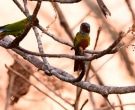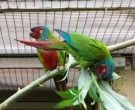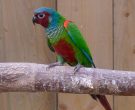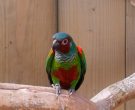Content |
|---|
Description:
22 to 23 cm.. length and an approximate weight of 80 g..
The Pfrimer's Parakeet (Pyrrhura pfrimeri) is a small psittacine of tail Long endemic Brazil very similar to Maroon-faced Parakeet (Pyrrhura leucotis), of which has recently been separated.
Its main color is green with bluish hues in primary rémiges and reddish tones in the back, the belly and retrizes penas. The bend of wing They are reddish.
The neck It has clear blue feathers with lighter edges, giving the whole a scaled aspect. The sides of the face They are red while the crown and nape They are bluish. The bill It is black and tail red-blue color at the tips
It has no sexual dimorphism.
Taxonomic status:
It has often been considered a subspecies of the Maroon-faced Parakeet (Pyrrhura leucotis) – Pyrrhura leucotis pfrimeri. The separation was made based on their distribution and the differences in habitat and plumage, I was the only member of the complex P. leucotis in which the light spot on ear-coverts It was very small. Recent mitochondrial DNA studies have confirmed this separate species status.
- Sound of the Pfrimer's Parakeet.
Habitat:
Its distribution is restricted to the forests dry deciduous or semi-evergreen growing on limestone outcrops in the calcareous. This habitat type caatinga is an isolated island within the surrounding savannah closed. The forest caatinga typically has a closed canopy and dense understory with lianas and some cacti, particularly in disturbed areas. The species has been seen recently fragmented woodlots (Olmos et al., 1998), but according to reports they do not live far from the edge of the forest.
Social, usually they are seen in flocks of up 10 birds. Noisy and conspicuous when they fly above the canopy. Difficult to see while feeding or resting in foliage.
Reproduction:
We know very little about their reproductive habits.
Food:
They fly in flocks in search of fruits, seeds, flowers and larvae insects (wasps Family Agaonidae).
Distribution and status:
Size of its range (Widgets / Resident): 20.300 km2
It is located in the Brazilian states of Goiás, Tocantins and the northwestern tip of Minas Gerais, Brazil.
Conservation:
State of conservation ⓘ |
||
|---|---|---|
 Endangered ⓘ (UICN)ⓘ
Endangered ⓘ (UICN)ⓘ
| ||
• Current category of the Red List of the UICN: In danger of extinction.
• Population trend: Decreasing.
• Population: 20,000-50,000.
Justification of the Red List of the Category
This species has a range very small highly fragmented and where habitat loss and degradation continue. For these reasons, It is classified as endangered.
Justification of the population
The total population is estimated to lie within the band 20,000-49,999 individuals (CA Bianchi in a little. 2006, 2007). The population density of the species has been estimated 11,7 individuals / km2 .
Justification trend
Given the rapid pace of deforestation within restricted range species, and its strong dependence on forest habitats suspected its population is declining rapidly (F. Olmos in some ., 2004).
Threats:
The main threat to this species is the deforestation driven selective logging, fires and conversion of habitat to pasture (Olmos et al . 1998). Dry wood Goiás He declined to be covering 15,8% of the region 1990 only the 5,8% in 1999, and less than 1% of the remaining fragments they were larger than 100 has (F. Olmos a slightly. 2007). There has been a reduction 66% habitat available in the last 31 years, with a current annual deforestation rate 2,1% (Bianchi 2010). Rapid deforestation is occurring within the range of the species to create pastures with widespread burning to improve poor pastures destroying the habitat of dry forest. It is mainly directed to logging forests durable normally used to make fence posts, and cement are starting to target areas of limestone outcroppings (CA Bianchi in a little . 2006, 2007). The species is rare while they recorded in the trade waves collections of exotic birds; This poses a potential threat (Olmos et al ., 1998). Population pressures increase as their range is close to the capital, Brasilia (Olmos et al ., 1998).
"Pfrimer's Parakeet" in captivity:
Very rare.
It's a bird in danger of extinction; each captive specimen of this species that is capable of reproducing, must be placed in a well-managed captive breeding program and not sold as a pet, in order to ensure its long-term survival.
Alternative names:
– Goias Parakeet, Pfrimer’s Conure, Pfrimer’s Parakeet (English).
– Conure de Pfrimer (French).
– Goiasittich, Pfrimers Sittich (German).
– tiriba de Pfrimer, Tiriba-de-pfrimer, Tiriba-do-paranã , ciganinha, barreirinha, chiriri e periquito-do-morro (Portuguese).
– Cotorra de Goiás (español).
scientific classification:

– Order: Psittaciformes
– Family: Psittacidae
– Genus: Pyrrhura
– Scientific name: Pyrrhura pfrimeri
– Citation: Miranda-Ribeiro, 1920
– Protonimo: Pyrrhura pfrimeri
Images Pfrimer's Parakeet:
Videos Cotorra de Goiás:
Pfrimer's Parakeet (Pyrrhura pfrimeri)
Sources:
- Avibase
- Parrots of the World – Forshaw Joseph M
- Parrots A Guide to the Parrots of the World – Tony Juniper & Mike Parr
- Birdlife
Photos:
(1) – Pyrrhura pfrimeri by Lander Van Nieuwenhuyse – Flickr
(2) – Pyrrhura pfrimeri by Lander Van Nieuwenhuyse – Flickr
(3) – Pyrrhura pfrimeri by Lander Van Nieuwenhuyse – Flickr
(4) – Pyrrhura pfrimeri by pyaf.net
(5) – Tiriba-de-Pfrimer, “Pyrrhura pfrimeri” – Pfrimer's Parakeet by Cláudia Brasileiro Martins
Brazilian Claudia Martins
(6) – Photo of Alipio de Miranda Ribeiro, brazilian natural scientist By File created by Flávio de Miranda Ribeiro (Picture taken by family) [CC BY-SA 3.0 or GFDL], via Wikimedia Commons
(7) – Parrots A Guide to the Parrots of the World – Tony Juniper & Mike Parr
- Sounds: Ciro Albano, XC57810. accessible www.xeno-canto.org/57810






